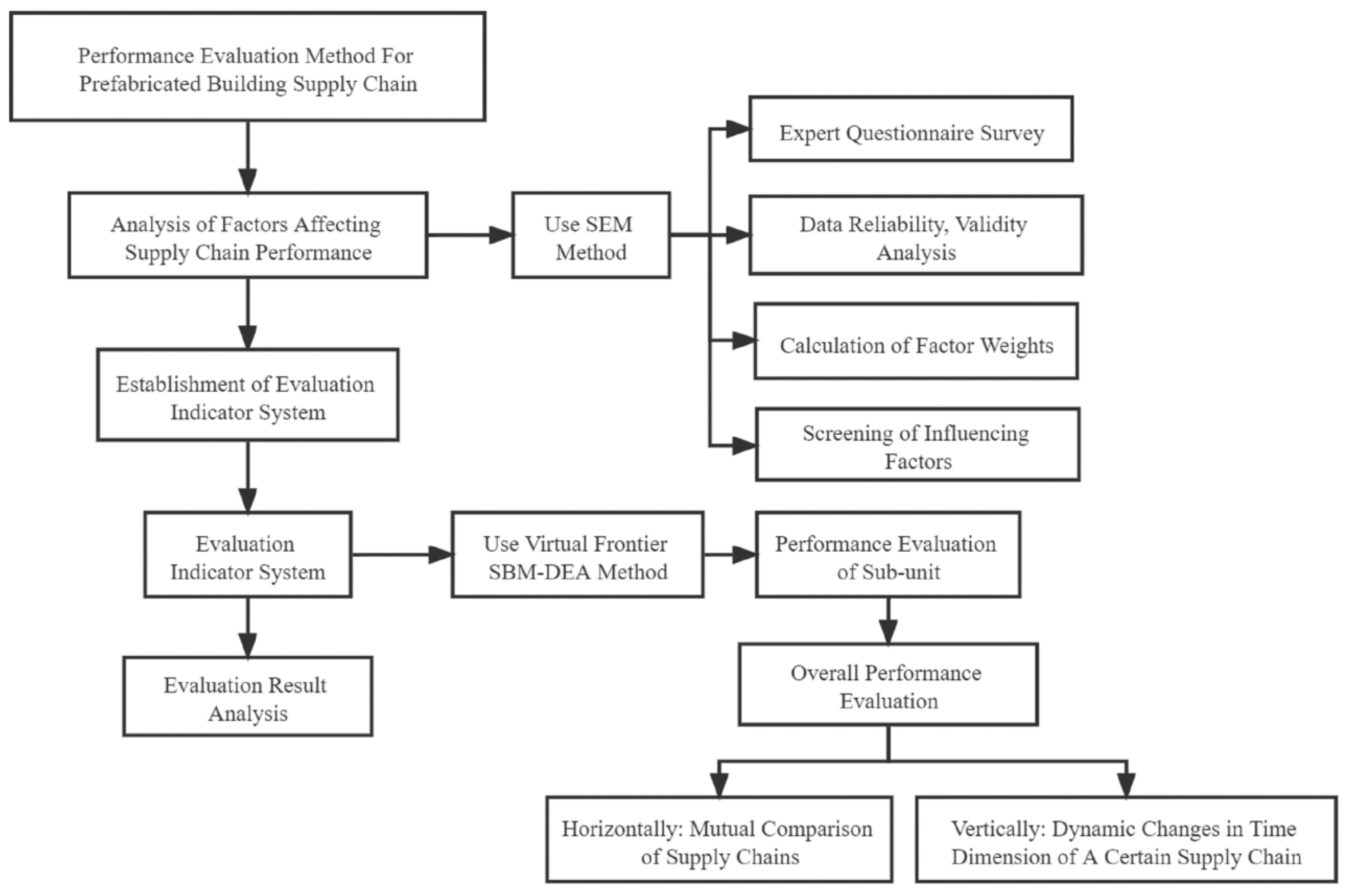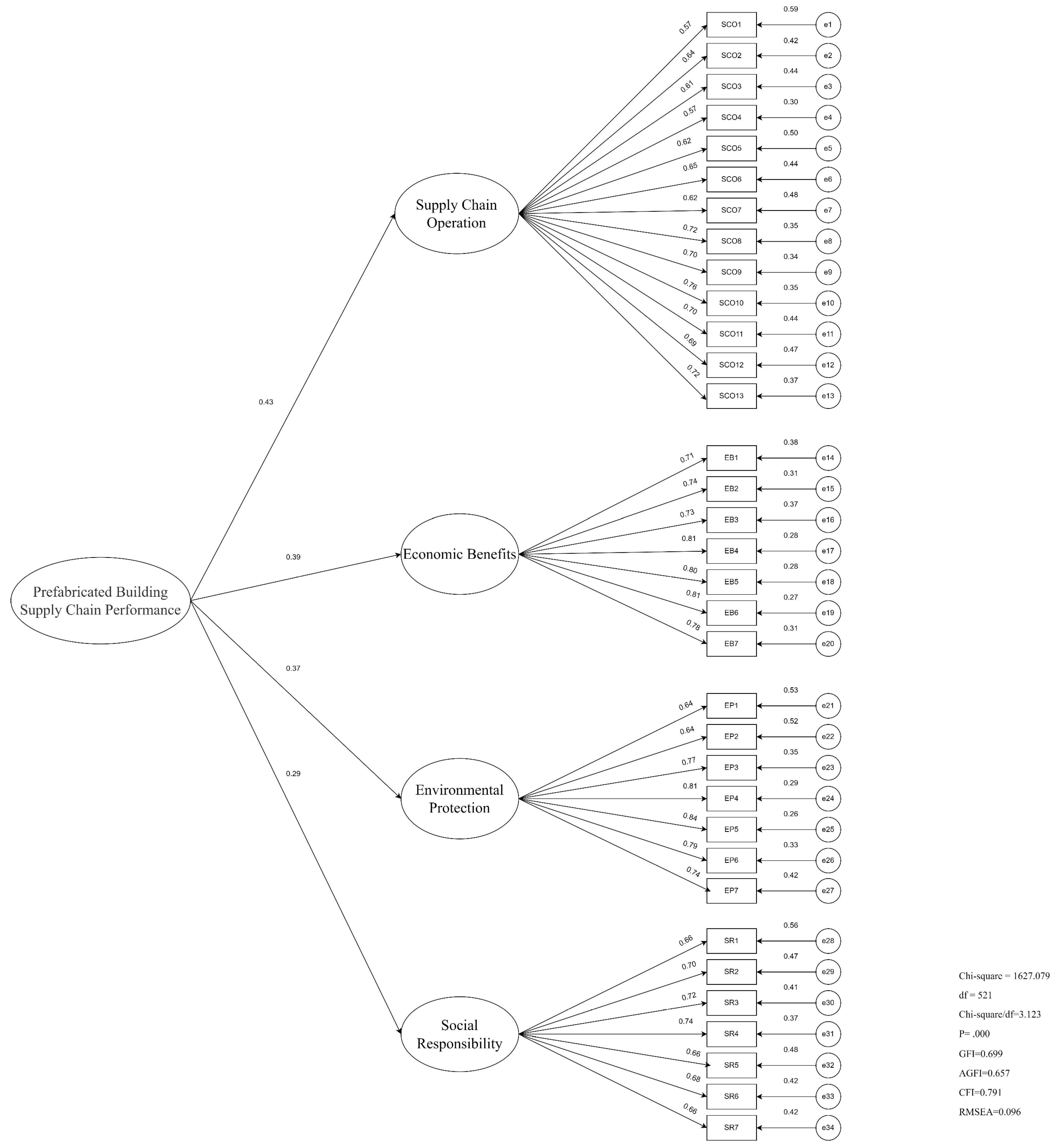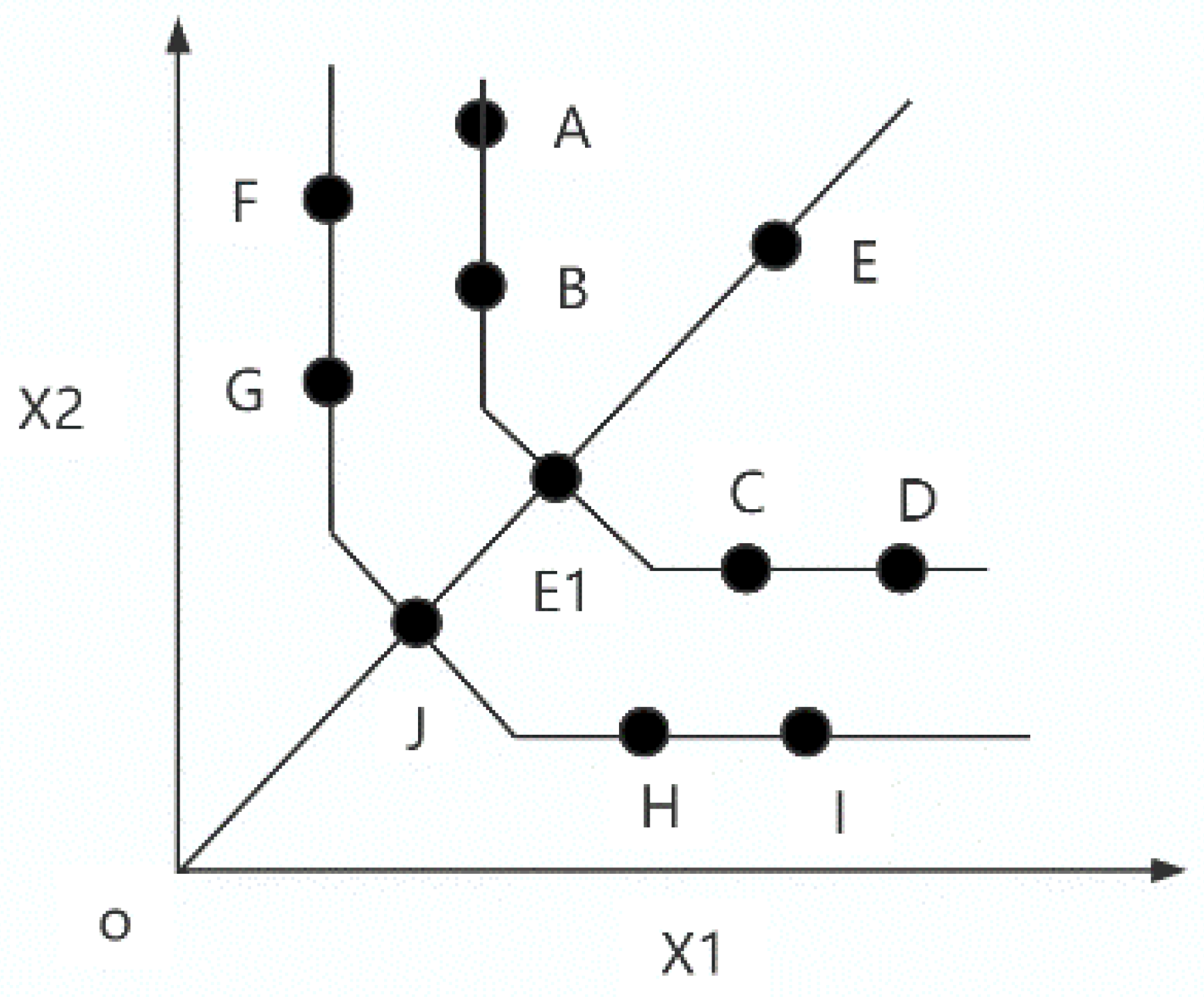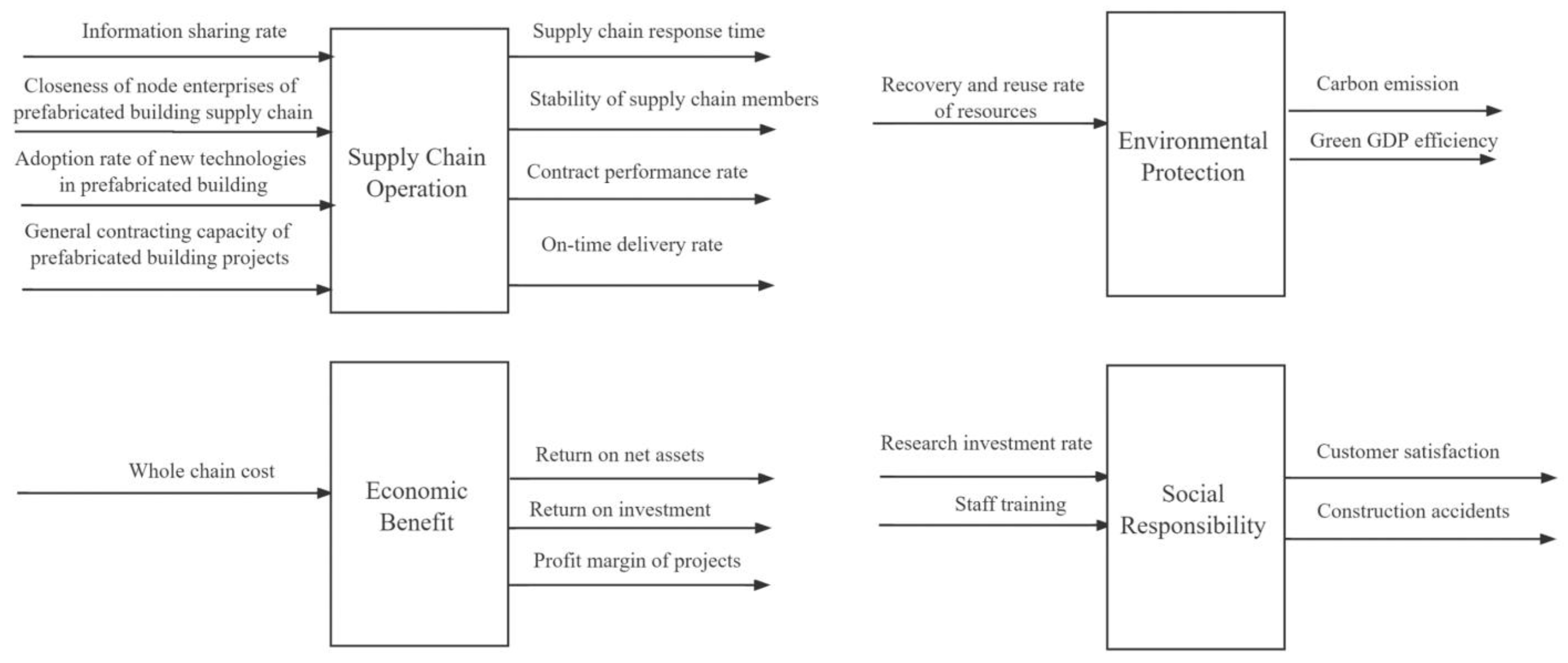An Evaluation of Supply Chain Performance of China’s Prefabricated Building from the Perspective of Sustainability
Abstract
:1. Introduction
2. Literature Review
2.1. Definition and Characteristics of Prefabricated Building Supply Chain
2.2. Performance Evaluation of Prefabricated Building Supply Chain
3. Materials and Methods
3.1. Analysis of Influencing Factors
3.1.1. Collection of Impact Factors
3.1.2. Questionnaire Survey
3.1.3. Data Processing
3.1.4. SEM Model Fitting and Correction
- (1)
- Measured model
- X represents the derived observed indicator, and Y represents the endogenous observed indicator;
- δ means measurement error of the derived variable, and ε is measurement error of the endogenous variable;
- ξ stands for derived latent variables, and η is endogenous latent variables;
- Λx represents the relationship between derived observed variable X and derived latent variable ξ, Λy indicates the relationship between endogenous observed variable Y and endogenous latent variable η [37].
- (2)
- Structural model
3.2. Establishment of an Indicator System
3.3. Establishment of Virtual Frontier SBM–DEA Evaluation Model
3.3.1. Introduction to Virtual Frontier SBM–DEA Evaluation Model
3.3.2. Establishment of Performance Evaluation Model of Supply Chain
- ISR0 (Information Sharing Rate) represents the information sharing rate of enterprises in the supply chain, and it serves as an input to the supply chain operation sub-unit.
- C0 (Closeness of node enterprises of prefabricated building supply chain) means the closeness of node enterprises in the supply chain, and it serves as the input of the supply chain operation sub-unit.
- AR0 (Adoption rate of new technologies in prefabricated building) indicates the degree of intelligence of prefabricated buildings, and it serves as an input for the supply chain operation sub-unit.
- GCC0 (General contracting capacity of prefabricated building projects) is the general contracting capacity of prefabricated building projects, and it serves as an input for the supply chain operation sub-unit.
- SCRT0 (Supply Chain Response Time) stands for response time of the supply chain, and it serves as the output of the supply chain operation sub-unit.
- SSCM0 (Stability of supply chain members) means the stability of supply chain members, and it serves as the output of the supply chain operation sub-unit.
- CPR0 (Contract Performance Rate) is contract performance rate, and it serves as the output of the supply chain operation sub-unit.
- OTDR0 (On-time delivery rate) indicates the on-time delivery rate, and it serves as the output of the supply chain operation sub-unit.
- λj represents weight of investment.
- ηj is weight of output.
- VISRj indicates virtual information sharing rate,
- VCj means closeness of virtual node enterprises,
- VARj stands for virtual degree of intelligence,
- VGCCj is virtual general contracting capability of projects,
- VSCRTj means virtual supply chain response time,
- VSSCMj represents virtual supply chain member stability,
- VCPRj is virtual contract performance rate,
- VOTDRj represents virtual delivery rate on time,
4. Case Study
5. Discussion
6. Conclusions
Author Contributions
Funding
Institutional Review Board Statement
Informed Consent Statement
Data Availability Statement
Conflicts of Interest
References
- Chan, L.F.; Wu, G.; Zhang, Y.B. Construction enterprise supply chain design research. In Proceedings of the International Conference on Mechatronics and Materials Processing (ICMMP), Guangzhou, China, 18–20 November 2011. [Google Scholar]
- Chen, X.; Tang, J.Y. Application of improved data envelopment analysis in construction supply chain management. In Proceedings of the 3rd International Conference on Civil, Architectural and Hydraulic Engineering (ICCAHE), Hangzhou, China, 30–31 July 2014. [Google Scholar]
- Li, R.J.; Liu, A.M. Study an circular economy-oriented building energy efficiency. In Proceedings of the International Conference on Construction and Real Estate Management, Bristol, UK, 21–22 August 2007. [Google Scholar]
- Akhimien, N.G.; Latif, E.; Hou, S.S. Application of circular economy principles in buildings: A systematic review. J. Build. Eng. 2020, 38, 102041. [Google Scholar] [CrossRef]
- Arashpour, M.; Bai, Y.; Aranda-Mena, G.; Bab-Hadiashar, A.; Hosseini, R.; Kalutara, P. Optimizing decisions in advanced manufacturing of prefabricated products: Theorizing supply chain configurations in off-site construction. Autom. Constr. 2017, 84, 146–153. [Google Scholar] [CrossRef]
- Ebrahimy, Y.; Abourizk, S.M.; Fernando, S.; Mohamed, Y. Simphony Supply Chain Simulator: A Simulation Toolkit to Model the Supply Chain of Construction Projects. Simulation 2011, 87, 657–667. [Google Scholar] [CrossRef]
- King, E. Global Academy, London: How offsite modular construction is reshaping education. Proc. Inst. Civ. Eng. Civ. Eng. 2020, 173, 35–38. [Google Scholar] [CrossRef]
- Liu, Y.; Dong, J.; Shen, L. A Conceptual Development Framework for Prefabricated Construction Supply Chain Management: An Integrated Overview. Sustainability 2020, 12, 1878. [Google Scholar] [CrossRef] [Green Version]
- Steinhardt, D.; Manley, K.; Bildsten, L.; Widen, K. The structure of emergent prefabricated housing industries: A comparative case study of Australia and Sweden. Constr. Manag. Econ. 2019, 38, 483–501. [Google Scholar] [CrossRef]
- Manley, K.; Widen, K. Prefabricated housing firms in Japan and Sweden: Learning from leading countries. In Offsite Production and Manufacturing for Innovative Construction—People Process, and Technology, 1st ed.; Goulding, J.S., Rahimian, F.P., Eds.; Routledge: London, UK, 2019; pp. 399–418. [Google Scholar]
- Lessing, J.; Brege, S. Business models for product-oriented house-building companies—Experience from two Swedish case studies. Constr. Innov. 2015, 15, 449–472. [Google Scholar] [CrossRef]
- Ekanayake, E.M.A.C.; Shen, G.Q.P.; Kumaraswamy, M.M. Identifying supply chain capabilities of construction firms in industrialized construction. Prod. Plan. Control 2020, 32, 303–321. [Google Scholar] [CrossRef]
- Farajmandi, M.; Ali, M.; Hermann, R.; Abourizk, S. A Decision Support Tool for Planning Module Installation in Industrial Construction. Eng. Constr. Arch. Manag. 2020, 27, 2615–2641. [Google Scholar] [CrossRef]
- Cheng, J.C. A web service framework for measuring and monitoring environmental and carbon footprintin construction supply chain. Procedia Eng. 2011, 14, 141–147. [Google Scholar] [CrossRef] [Green Version]
- Demiralp, G.; Guven, G.; Ergen, E. Analyzing the Benefits of Rfid Technology for Cost Sharing in Construction Supply Chains: A Case Study on Prefabricated Precast Components. Autom. Constr. 2012, 24, 120–129. [Google Scholar] [CrossRef]
- Eriksson, P.E. Partnering in Engineering Projects: Four Dimensions of Supply Chain Integration. J. Purch. Supply Manag. 2015, 21, 38–50. [Google Scholar] [CrossRef] [Green Version]
- Shin, T.-H.; Chin, S.; Yoon, S.-W.; Kwon, S.-W. A service-oriented integrated information framework for RFID/WSN-based intelligent construction supply chain management. Autom. Constr. 2011, 20, 706–715. [Google Scholar] [CrossRef]
- Zhu, M.Q.; Zou, Z.X. Green supply chain management in construction industry. In Proceedings of the International Conference on Computing, Information and Control (ICCIC), Wuhan, China, 17–18 September 2011. [Google Scholar]
- Kamali, M.; Hewage, K. Development of Performance Criteria for Sustainability Evaluation of Modular Versus Conventional Construction Methods. J. Clean. Prod. 2017, 142, 3592–3606. [Google Scholar] [CrossRef]
- Chang, C.G.; Zhao, T. Gt-sem-based safety risk mechanism of prefabricated construction. In Proceedings of the 12th International Conference on Communication Software and Networks (ICCSN), Chongqing, China, 12–15 June 2020. [Google Scholar] [CrossRef]
- Li, X.J. Research on Investment Risk Influence Factors of Prefabricated Building Projects. J. Civ. Eng. Manag. 2020, 26, 599–613. [Google Scholar] [CrossRef]
- Wang, X.; Jiang, C.; Sun, D. Research on performance measurement of prefabricated housing supply chain based on network DEA. Build. Econ. 2017, 38, 89–94. [Google Scholar]
- Kim, S.-Y.; Nguyen, V.T. A Structural model for the impact of supply chain relationship traits on project performance in construction. Prod. Plan. Control 2017, 29, 170–183. [Google Scholar] [CrossRef]
- Mafini, C.; Poobie, P. A Diagnostic Review of the Barriers to Supply Chain Management in Construction Supply Chains. In Proceedings of the 6th IISES Business and Management Conference, Geneva, Switzerland, 27–30 June 2017. [Google Scholar]
- Kim, Y.-W.; Han, S.-H.; Yi, J.-S.; Chang, S. Supply chain cost model for prefabricated building material based on time-driven activity-based costing. Can. J. Civ. Eng. 2016, 43, 287–293. [Google Scholar] [CrossRef]
- Liu, K.; Su, Y.; Zhang, S. Evaluating Supplier Management Maturity in Prefabricated Construction Project-Survey Analysis in China. Sustainability 2018, 10, 3046. [Google Scholar] [CrossRef] [Green Version]
- Ekanayake, E.M.A.C.; Shen, G.Q.; Kumaraswamy, M.M.; Owusu, E.K.; Saka, A.B. Modeling Supply Chain Resilience in Industrialized Construction: A Hong Kong Case. J. Constr. Eng. Manag. 2021, 147, 11. [Google Scholar] [CrossRef]
- Chen, Q.; Hall, D.M.; Adey, B.T.; Haas, C.T. Identifying enablers for coordination across construction supply chain processes: A systematic literature review. Eng. Constr. Arch. Manag. 2020, 28, 1083–1113. [Google Scholar] [CrossRef]
- Hsu, P.-Y.; Aurisicchio, M.; Angeloudis, P. Risk-averse supply chain for modular construction projects. Autom. Constr. 2019, 106, 102898. [Google Scholar] [CrossRef]
- Lyons, R.E.; Roulstone, A.R.M. Production learning in a small modular reactor supply chain. In Proceedings of the International Congress on Advances in Nuclear Power Plants, Charlotte, NC, USA, 8–11 April 2018; pp. 1034–1041. [Google Scholar]
- Wuni, I.Y.; Shen, G.Q. Critical success factors for modular integrated construction projects: A review. Build. Res. Inf. 2020, 48, 763–784. [Google Scholar] [CrossRef]
- Liu, A.; Xiaohui, L. Research on the construction of a comprehensive performance evaluation index system of an integrated construction supply chain. In Proceedings of the International Conference on Construction and Real Estate Management (ICCREM), Lulea, Sweden, 11–12 August 2015. [Google Scholar]
- Cheng, J.C.; Law, K.H.; Bjornsson, H.; Jones, A.; Sriram, R.D. Modeling and monitoring of construction supply chains. Adv. Eng. Inform. 2010, 24, 435–455. [Google Scholar] [CrossRef] [Green Version]
- Chen, Y.; Leishan, Z. Community property analysis and optimization in cooperative construction supply chain networks. In Proceedings of the International Conference on Construction and Real Estate Management, Bristol, UK, 21–22 August 2007. [Google Scholar]
- Rosete, J.C.G.-P.; Barros, R.H.; Blanco-Jiménez, M. SEM analysis on Global Fortune 500 Corporations with green ratings. Energy Effic. 2020, 13, 1135–1145. [Google Scholar] [CrossRef]
- Deng, M.R.; Zhang, L.J. A systematic study on supply chain collaboration in construction. In Proceedings of the International Conference on Construction and Real Estate Management, Penang, Malaysia, 12–13 December 2005. [Google Scholar]
- Di, C.; Ziyou, G. The scale-free property and its weight of construction supply chain networks. In Proceedings of the International Conference on Construction and Real Estate Management, Bristol, UK, 21–22 August 2007. [Google Scholar]
- Ashuri, B.; Wang, J.; Shahandashti, M.; Baek, M. A data envelopment analysis (DEA) model for building energy benchmarking. J. Eng. Des. Technol. 2019, 17, 747–768. [Google Scholar] [CrossRef]
- Luo, L.Z.; Shen, G.Q.; Xu, G.Y.; Liu, L.Y.; Wang, Y. Stakeholder-Associated Supply Chain Risks and Their Interactions in a Prefabricated Building Project in Hong Kong. J. Manag. Eng 2019, 35, 05018015. [Google Scholar] [CrossRef]
- Gao, F. Research on risk analysis and control of construction supply chain. In Proceedings of the 4th International Conference on Operations and Supply Chain Management/15th Annual Meeting of the Asia-Pacific-Decision-Sciences-Institute, Hong Kong, China, 25–31 July 2010. [Google Scholar]
- Hou, X.P.; Wang, Y.W.; Zhang, Y.; Zhang, Y.J. Research on the construction supply chain management based on neural network. In Proceedings of the International Conference on Construction and Real Estate Management, Penang, Malaysia, 12–13 December 2005. [Google Scholar]
- Hu, J. The research on supply chain management in public construction project. In Proceedings of the International Conference on Construction and Real Estate Management, Bristol, UK, 21–22 August 2007. [Google Scholar]
- Masood, R.; Lim, J.B.; González, V.A. Performance of the supply chains for New Zealand prefabricated house-building. Sustain. Cities Soc. 2020, 64, 102537. [Google Scholar] [CrossRef]
- Kahkonen, K.; Koskela, L.; Leinonen, J.; Aromaa, P. Supply chain management aspects for top quality industrial construction. In Proceedings of the 10th International Symposium on Construction Innovation and Global Competitiveness, Cincinnati, OH, USA, 9–13 September 2002. [Google Scholar]
- Moon, S.; Zekavat, P.R.; Bernold, L.E. Dynamic Control of Construction Supply Chain to Improve Labor Performance. J. Constr. Eng. Manag. 2015, 141, 5015002. [Google Scholar] [CrossRef]
- Luo, L.; Jin, X.; Shen, G.Q.; Wang, Y.; Liang, X.; Li, X.; Li, C.Z. Supply Chain Management for Prefabricated Building Projects in Hong Kong. J. Manag. Eng. 2020, 36, 05020001. [Google Scholar] [CrossRef]
- Hu, W.; Xinhua, H. Communication improvement for integrated construction supply chain management systems. In Proceedings of the International Conference on Logistics Engineering and Supply Chain, Changsha, China, 20–22 August 2008. [Google Scholar]
- Huang, C. A study of the application of supply chain management in construction industry. In Proceedings of the 12th Wuhan International Conference on E-Business, Wuhan, China, 29–31 October 2013. [Google Scholar]
- Jin, M.H.; Wang, Y.W. Study on the framework of construction supply chain quality management. In Proceedings of the International Conference on Construction and Real Estate Management, Penang, Malaysia, 12–13 December 2005. [Google Scholar]
- Liu, S.; Mansoor, A.; Bouferguene, A.; Al-Hussein, M. The performance evaluation of different modular construction supply chain configurations using discrete event simulation. In Proceedings of the Construction Research Congress (CRC) on Construction Research and Innovation to Transform Society, Tempe, AZ, USA, 8–10 March 2020. [Google Scholar]
- Cheng, B.; Lu, K.; Li, J.; Chen, H.; Luo, X.; Shafique, M. Comprehensive assessment of embodied environmental impacts of buildings using normalized environmental impact factors. J. Clean. Prod. 2022, 334, 130083. [Google Scholar] [CrossRef]
- Pan, N.-H.; Lee, M.-L.; Chen, S.-Q. Construction Material Supply Chain Process Analysis and Optimization. J. Civ. Eng. Manag. 2011, 17, 357–370. [Google Scholar] [CrossRef] [Green Version]
- Li, X.D.; Zhang, Y.J.; Hou, X.P. The comparative research on construction supply chain management and manufacturing supply chain management. In Proceedings of the International Conference on Construction and Real Estate Management, Penang, Malaysia, 12–13 December 2005. [Google Scholar]
- Xie, L.L.; Chen, Y.J.; Chang, R.D. Scheduling Optimization of Prefabricated Construction Projects by Genetic Algorithm. Appl. Sci. 2021, 11, 5531. [Google Scholar] [CrossRef]
- Li, W.Q.; Wang, Y.W.; Zhao, X.F. A framework for construction supply chain operations reference-model. In Proceedings of the International Conference on Construction and Real Estate Management, Penang, Malaysia, 12–13 December 2005. [Google Scholar]









| Supply Chain of Prefabricated Building | Supply Chain of Traditional Building | Supply Chain of Manufacturing | |
|---|---|---|---|
| Production mode | Make-to-order | Build to project | Production according to market forecast |
| Production characteristics | Mass repetitive manufacturing | One-time production and non-reproducibility | Mass production and large-scale replication |
| Place of production | Factory production, on-site assembly | Materials are manufactured on the construction site | Made in the factory |
| Design | Less design changes | More design changes | Basically unchanged design |
| Latent Variable | S/N | Observed Variable | S/N |
|---|---|---|---|
| Supply Chain Operation | SCO | Flexible schedule | SCO1 |
| Rate of excellent engineering quality | SCO2 | ||
| Project winning rate | SCO3 | ||
| Supply chain response time | SCO4 | ||
| Rate of qualified products | SCO5 | ||
| Information sharing rate | SCO6 | ||
| Risk control capability of prefabricated building enterprises | SCO7 | ||
| Closeness of node enterprises of prefabricated building supply chain | SCO8 | ||
| Adoption rate of new technologies in prefabricated building | SCO9 | ||
| General contracting capacity of prefabricated building projects | SCO10 | ||
| Stability of supply chain members | SCO11 | ||
| Contract performance rate | SCO12 | ||
| On-time delivery rate | SCO13 | ||
| Economic Benefits | EB | Profit growth rate | EB1 |
| Rate of return on total assets | EB2 | ||
| Labor productivity | EB3 | ||
| Return on net assets | EB4 | ||
| Return on investment | EB5 | ||
| Profit margin of projects | EB6 | ||
| Whole chain cost | EB7 | ||
| Environmental Protection | EP | Pollutant discharge rate | EP1 |
| Green procurement rate | EP2 | ||
| Carbon emission | EP3 | ||
| Green GDP efficiency | EP4 | ||
| Recovery and reuse rate of resources | EP5 | ||
| Resource saving rate | EP6 | ||
| Environmental impact | EP7 | ||
| Social Responsibility | SR | Employee satisfaction | SR1 |
| Customer satisfaction | SR2 | ||
| Staff training | SR3 | ||
| Construction accidents | SR4 | ||
| Social contribution | SR5 | ||
| Research investment rate | SR6 | ||
| Social credibility | SR7 |
| Latent Variable | Weight | Observation Variable | Weight | Result | ||
|---|---|---|---|---|---|---|
| Supply Chain Operation | SCO | 0.3 | Flexible schedule | SCO1 | 0.07 | delete |
| Rate of excellent engineering quality | SCO2 | 0.07 | delete | |||
| Project winning rate | SCO3 | 0.07 | delete | |||
| Supply chain response time | SCO4 | 0.08 | reserve | |||
| Rate of qualified products | SCO5 | 0.07 | delete | |||
| Information sharing rate | SCO6 | 0.08 | reserve | |||
| Risk control capability of prefabricated building enterprises | SCO7 | 0.07 | delete | |||
| Closeness of node enterprises of prefabricated building supply chain | SCO8 | 0.08 | reserve | |||
| Adoption rate of new technologies in prefabricated building | SCO9 | 0.08 | reserve | |||
| General contracting capacity of prefabricated building projects | SCO10 | 0.09 | reserve | |||
| Stability of supply chain members | SCO11 | 0.08 | reserve | |||
| Contract performance rate | SCO12 | 0.08 | reserve | |||
| On-time delivery rate | SCO13 | 0.08 | reserve | |||
| Economic Benefits | EB | 0.26 | Profit growth rate | EB1 | 0.12 | delete |
| Rate of return on total assets | EB2 | 0.14 | delete | |||
| Labor productivity | EB3 | 0.14 | delete | |||
| Return on net assets | EB4 | 0.15 | reserve | |||
| Return on investment | EB5 | 0.15 | reserve | |||
| Profit margin of projects | EB6 | 0.15 | reserve | |||
| Whole chain cost | EB7 | 0.15 | reserve | |||
| Environmental Protection | EP | 0.24 | Pollutant discharge rate | EP1 | 0.12 | delete |
| Green procurement rate | EP2 | 0.12 | delete | |||
| Carbon emission | EP3 | 0.16 | reserve | |||
| Green GDP efficiency | EP4 | 0.16 | reserve | |||
| Recovery and reuse rate of resources | EP5 | 0.16 | reserve | |||
| Resource saving rate | EP6 | 0.14 | delete | |||
| Environmental impact | EP7 | 0.14 | delete | |||
| Social Responsibility | SR | 0.2 | Employee satisfaction | SR1 | 0.14 | delete |
| Customer satisfaction | SR2 | 0.15 | reserve | |||
| Staff training | SR3 | 0.15 | reserve | |||
| Construction accidents | SR4 | 0.15 | reserve | |||
| Social contribution | SR5 | 0.12 | delete | |||
| Research investment rate | SR6 | 0.15 | reserve | |||
| Social credibility | SR7 | 0.14 | delete | |||
| Latent Variable | Measurement Variable | ||
|---|---|---|---|
| Supply chain operation | SCO | Supply chain response time | SCO4 |
| Information sharing rate | SCO6 | ||
| Closeness of node enterprises of prefabricated building supply chain | SCO8 | ||
| Adoption rate of new technologies in prefabricated building | SCO9 | ||
| General contracting capacity of prefabricated building projects | SCO10 | ||
| Stability of supply chain members | SCO11 | ||
| Contract performance rate | SCO12 | ||
| On-time delivery rate | SCO13 | ||
| Economic Benefits | EB | Return on net assets | EB4 |
| Return on investment | EB5 | ||
| Profit margin of projects | EB6 | ||
| Whole chain cost | EB7 | ||
| Environmental Protection | EP | Carbon emission | EP3 |
| Green GDP efficiency | EP4 | ||
| Recovery and reuse rate of resources | EP5 | ||
| Social Responsibility | SR | Customer satisfaction | SR2 |
| Staff training | SR3 | ||
| Construction accidents | SR4 | ||
| Research investment rate | SR6 | ||
| Supply Chain Operation | Economic Benefits | Environmental Protection | Social Responsibility | Total Performance | |
|---|---|---|---|---|---|
| C | 0.98 | 0.79 | 0.33 | 0.98 | 0.77 |
| B | 0.99 | 0.98 | 0.28 | 0.76 | 0.77 |
| A | 0.96 | 0.21 | 0.99 | 0.55 | 0.69 |
| M | 0.97 | 0.11 | 0.95 | 0.53 | 0.65 |
| N | 0.96 | 0.12 | 0.40 | 0.98 | 0.61 |
| G | 0.91 | 0.13 | 0.94 | 0.41 | 0.61 |
| K | 0.96 | 0.68 | 0.18 | 0.51 | 0.61 |
| E | 0.98 | 0.20 | 0.22 | 0.99 | 0.60 |
| J | 0.96 | 0.05 | 0.21 | 0.99 | 0.55 |
| H | 0.93 | 0.21 | 0.32 | 0.63 | 0.54 |
| L | 0.98 | 0.07 | 0.43 | 0.58 | 0.53 |
| D | 0.99 | 0.10 | 0.50 | 0.41 | 0.52 |
| I | 0.91 | 0.04 | 0.15 | 0.91 | 0.50 |
| F | 0.89 | 0.03 | 0.18 | 0.45 | 0.41 |
| Supply Chain Name | Supply Chain Operation | Economic Benefits | Environmental Protection | Social Responsibility | Total Performance |
|---|---|---|---|---|---|
| C | 1.00 | 1.00 | 0.33 | 1.00 | 0.84 |
| B | 1.00 | 1.00 | 0.28 | 0.76 | 0.78 |
| A | 1.00 | 0.32 | 1.00 | 0.55 | 0.73 |
| M | 1.00 | 0.18 | 1.00 | 0.53 | 0.69 |
| K | 0.96 | 0.91 | 0.19 | 0.51 | 0.67 |
| N | 1.00 | 0.19 | 0.40 | 1.00 | 0.65 |
| E | 1.00 | 0.31 | 0.23 | 1.00 | 0.64 |
| G | 0.90 | 0.20 | 0.92 | 0.41 | 0.62 |
| H | 1.00 | 0.39 | 0.33 | 0.63 | 0.60 |
| J | 1.00 | 0.10 | 0.22 | 1.00 | 0.58 |
| L | 1.00 | 0.11 | 0.44 | 0.58 | 0.55 |
| D | 1.00 | 0.16 | 0.50 | 0.41 | 0.54 |
| I | 0.90 | 0.08 | 0.16 | 0.91 | 0.51 |
| F | 1.00 | 0.05 | 0.19 | 0.45 | 0.45 |
| Time | Supply Chain Operation | Economic Benefits | Environmental Protection | Social Responsibility | Total Performance |
|---|---|---|---|---|---|
| 2016 | 1 | 1 | 1 | 1 | 1 |
| 2017 | 1.50 | 1.94 | 1.57 | 1.20 | 1.57 |
| 2018 | 0.74 | 0.06 | 0.06 | 0.40 | 0.33 |
| 2019 | 0.94 | 1.33 | 1.33 | 1.62 | 1.27 |
| 2020 | 0.97 | 0.32 | 0.32 | 0.15 | 0.48 |
Publisher’s Note: MDPI stays neutral with regard to jurisdictional claims in published maps and institutional affiliations. |
© 2022 by the authors. Licensee MDPI, Basel, Switzerland. This article is an open access article distributed under the terms and conditions of the Creative Commons Attribution (CC BY) license (https://creativecommons.org/licenses/by/4.0/).
Share and Cite
Zhao, S.; Wang, J.; Ye, M.; Huang, Q.; Si, X. An Evaluation of Supply Chain Performance of China’s Prefabricated Building from the Perspective of Sustainability. Sustainability 2022, 14, 1299. https://doi.org/10.3390/su14031299
Zhao S, Wang J, Ye M, Huang Q, Si X. An Evaluation of Supply Chain Performance of China’s Prefabricated Building from the Perspective of Sustainability. Sustainability. 2022; 14(3):1299. https://doi.org/10.3390/su14031299
Chicago/Turabian StyleZhao, Shiman, Junwu Wang, Mengwei Ye, Qiyun Huang, and Xiang Si. 2022. "An Evaluation of Supply Chain Performance of China’s Prefabricated Building from the Perspective of Sustainability" Sustainability 14, no. 3: 1299. https://doi.org/10.3390/su14031299
APA StyleZhao, S., Wang, J., Ye, M., Huang, Q., & Si, X. (2022). An Evaluation of Supply Chain Performance of China’s Prefabricated Building from the Perspective of Sustainability. Sustainability, 14(3), 1299. https://doi.org/10.3390/su14031299







